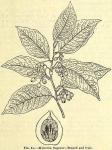154. Myristica.—Nutmeg.
 The kernel of the ripe seed of Myris'tica frag'rans Houttuyn.
The kernel of the ripe seed of Myris'tica frag'rans Houttuyn.
BOTANICAL CHARACTERISTICS.—Tree about 30 feet high. Leaves oblong-oval, entire, glossy above, whitish beneath, aromatic. Flowers dioecious; male flowers in axillary clusters; female flowers single, solitary, and axillary, both very small and of a pale yellow color.
HABITAT.—Molucca Islands; cultivated in adjacent East India islands, and especially in the Dutch Banda Islands, whence most of the nutmegs are imported for market.
DESCRIPTION OF DRUG.—A roundish or oval kernel about 25 mm. (1 in.) long; externally light grayish-brown, marked with worm-shaped furrows and covered with lime (done by the Dutch growers to kill the germ, thinking in this way to monopolize its cultivation). They are hard and not readily pulverizable, but can easily be cut or grated, showing a waxy luster; internally yellowish, a cross-section having a mottled appearance, due to the penetration to the albumen of the inner seed-coat in narrow brown strips; these strips contain oily material; hilum and micropyle on the broad end, chalaza near the upper end, united by a groove corresponding to the raphé; the embryo is small, in a cavity at the base; odor strongly aromatic; taste warm and aromatic.
The male, wild, or long nutmeg, as it is variously termed, is occasionally found in market- it is much longer than the official nutmeg, elliptical, destitute of the dark brown inner veins, and of a bitter and disagreeable taste. Penang and Singapore nutmegs are unlimed.
California nutmeg, so called, is the seed of Torreya Californica (nat. ord. Coniferae); testa smooth, brownish, internally marbled, resembling nutmeg, but has a terebinthinate odor and taste.
Powder.—Characteristic elements: See Part iv, Chap. I, B.
CONSTITUENTS.—The greater portion of nutmeg (25 to 30 per cent.) consists of a fixed oil; this is official in the British Pharmacopoeia and is called oil of mace or mace butter; it contains chiefly myristin, with some myristic acid, olein, palmitin, resin, and volatile oil (see 154 b). The aromatic properties of nutmeg depend upon 2 to 8 per cent. of volatile oil. Ash, not exceeding 5 per cent.
ACTION AND USES.—Aromatic stimulant and stomachic. Used as a corrective and as a condiment. In large doses it possesses narcotic properties. Dose: 8 to 30 gr. (0.5 to 2 Gm.).
OFFICIAL PREPARATIONS.
154a. Oleum Myristicae, U.S.—OIL OF NUTMEG. A thin, colorless or pale straw-colored volatile oil, lighter than water, and having the characteristic properties of nutmeg; on standing for a considerable length of time it becomes darker and thicker, and deposits a crystalline fatty glyceride of myristic acid. It contains a hydrocarbon, pinene, myristicin, and an oxygenated compound, myristicol, isomeric with carvol. Action and uses same as nutmeg, but rarely used. Dose: 1 to 3 drops (0.065 to 0.2 mil).
154b. OLEUM MYRISTICAE EXPRESSUM.—EXPRESSED OIL OF NUTMEG. MACE BUTTER (see Myristica Constituents). Unctuous blocks, marbled whitish and brown. Mostly used externally.
155. Macis.
155. Macis, N.F. (U.S. 1890).—The thick membrane or "arillode" immediately investing the kernel of the nutmeg. It comes in narrow bands, irregularly slit above into somewhat branched and lobed divisions, united at the base in an unbroken band; reddish or orange-yellow in color, with a fatty feeling when scratched or pressed; peculiar aromatic odor and taste. It contains volatile oil (about 8 per cent.), a red fixed oil, gum, resin, sugar, and proteids, but no starch. Aromatic stimulant and tonic; mostly used as a flavoring agent. Dose: 5 to 20 gr. (0.3 to 1.3 Gm.).

